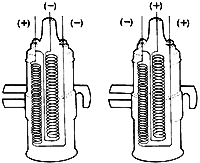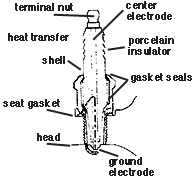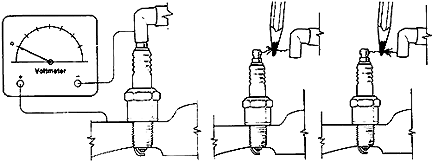Coil Polarity
I was converting my older British car over from positive to negative ground when I came across the question of coil polarity. I discovered coil polarity is very much misunderstood. In researching it, I was very confused until I found out there are two definitions of coil polarity. I talked to three or four knowledgeable people on the subject and read several technical books and articles. Everything made sense in itself but didn't jive together until I found out they were talking apples and oranges.
Definition #l Coil Polarity (In relation to battery)
 The polarity of the coil should match that of the battery by connecting it so (+) goes to (+) and (-) connects to (-). But don't worry about which way you install the battery (positive or negative ground) or which way you install the coil (regardless of coil markings) it will automatically adjust itself. The coil will work efficiently and put out the same voltage either way it is hooked up, but the spark plugs are more sensitive when it comes to polarity, hence our second and more important definition.
The polarity of the coil should match that of the battery by connecting it so (+) goes to (+) and (-) connects to (-). But don't worry about which way you install the battery (positive or negative ground) or which way you install the coil (regardless of coil markings) it will automatically adjust itself. The coil will work efficiently and put out the same voltage either way it is hooked up, but the spark plugs are more sensitive when it comes to polarity, hence our second and more important definition.
Definition #2 Coil Polarity (In relation to spark plugs)
Coil polarity should be such so as to provide negative polarity to the spark plugs center electrode.
It has been found that it takes approximately 15% less voltage to form an arc at the plugs, if the hotter center electrode is negative, and the cooler (by comparison) ground electrode is positive. The center electrode is hotter since heat transfer from the tip must make its way through the porcelain insulator past the sealing gaskets to the shell block and then to the water jackets.

If your center electrode is positive, your car will probably still run fine until, with its 15% handicap, it exceeds the coil output. If you live where temperatures dip down to 0° you may not get your car started. Driving with a full load and accelerating hard up a hill may cause an ignition miss. If your ignition system is well worn to where you have various voltage losses, you could get a miss.
Correct coil polarity won't eliminate these problems, just put them off by 15%.
If your coil has - & + markings by the primary terminals, you will be pretty safe by hooking it up by those marks, but test it for correct polarity anyway, using one of the tests listed further on. If your coil has CB & SW or BAT & DIST markings, there is no way of telling if the coil was marked in relation to a positive or negative ground car, and the only sure way to tell if the coil is installed right is to test it out.

You test for correct polarity by hooking up a voltmeter with the negative lead to the plug terminal (which should be of negative polarity) and the positive lead to the block (which should be of positive polarity). Set the meter on the highest volt range. These connections remain the same whether you have a positive ground or negative ground electrical system. The secondary winding's polarity which we are testing is determined by the combined hookup of the battery and primary windings, so it may or may not match the battery's ground.
Cranking the engine over (you don't have to start it) should show an upward swing of the voltmeter needle (don't be concerned with taking a reading). If the needle swings down off the scale, your coil is hooked up wrong. To correct, reverse coil primary leads. Do not worry about the coil markings (refer to definition #1).
If you don't have a voltmeter, test by removing a plug wire from a plug and hold a plain lead pencil point in the path of the arc. A flair (hard to see) towards the plug shows correct polarity while a flair towards the coil shows reversed polarity.
Back to General Tech Tips
|

